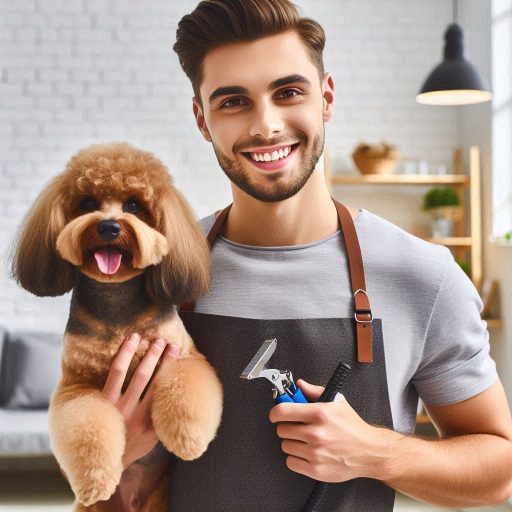Introduction
Pet grooming and veterinary care are vital services for the health of your beloved pet.
Pet grooming involves taking care of your pet’s hygiene and appearance, such as bathing, brushing, and nail trimming.
Veterinary care focuses on medical services, including regular check-ups, vaccinations, and treatment of illnesses or injuries.
Importance of Both Services
Pet grooming is essential for maintaining your pet’s physical health, preventing matting, and keeping their coat clean to avoid skin issues.
Regular grooming also helps detect early signs of health problems.
On the other hand, veterinary care ensures your pet’s overall well-being by monitoring their health, preventing diseases through vaccinations, and providing necessary medical treatment when needed.
It is crucial for early diagnosis and prompt intervention in case of any health issues.
Both services work hand in hand to keep your pet healthy and happy.
Key differences in education and training
When it comes to the education and training required for pet grooming versus veterinary care, there are significant variations in the depth and breadth of knowledge needed in each profession.
Specific training and education required for pet groomers
Pet groomers typically undergo vocational training programs or apprenticeships to learn the necessary skills for grooming various types of pets.
These programs cover topics such as bathing, grooming techniques, breed-specific grooming standards, handling pets, and customer service.
Some pet groomers may choose to pursue certification through professional organizations to enhance their skills and credibility in the industry.
Continuing education courses are also available for pet groomers to stay updated on the latest grooming trends and techniques.
Overall, pet grooming education focuses on practical skills and hands-on training to groom pets effectively and safely.
Extensive education and training needed for veterinarians, including medical school
Veterinarians, on the other hand, must complete a rigorous educational path that includes earning a bachelor’s degree, followed by four years of veterinary school.
During veterinary school, students study subjects such as anatomy, physiology, pharmacology, surgery, radiology, and animal behavior.
After graduating from veterinary school, aspiring veterinarians must pass the North American Veterinary Licensing Examination (NAVLE) to become licensed practitioners.
Some veterinarians choose to pursue advanced training in specialized areas such as surgery, oncology, cardiology, or dermatology through internships and residencies.
Continuing education is also essential for veterinarians to keep abreast of the latest advancements in veterinary medicine and treatments.
In essence, while both pet groomers and veterinarians play important roles in ensuring the health and well-being of pets, the education and training required for each profession differ significantly in terms of depth, scope, and duration.
Transform Your Career Today
Unlock a personalized career strategy that drives real results. Get tailored advice and a roadmap designed just for you.
Start NowRead: Eco-Friendly Pet Grooming Products to Use
Scope of practice
When it comes to the scope of practice, pet groomers and veterinarians have distinct roles and responsibilities:
Pet Grooming Tasks and Services
Grooming services entail bathing, brushing, and styling pets to maintain their appearance and cleanliness.
Nail trimming is a crucial task to prevent overgrowth and potential injuries to the pet.
Ear cleaning helps prevent infections and promotes overall ear health for the animal.
Brushing teeth, trimming fur, and expressing anal glands are additional services offered by pet groomers.
Veterinary Care Services
Veterinarians are trained professionals who diagnose and treat illnesses, injuries, and health conditions in animals.
They perform physical exams, order diagnostic tests, administer vaccines, and prescribe medications as necessary.
Surgical procedures, such as spaying and neutering, dental cleanings, and tumor removals, are performed by veterinarians.
Emergency care, chronic disease management, and preventive healthcare, like flea and tick prevention, are also part of their services.
While pet groomers focus on the aesthetic and hygiene aspects of pet care, veterinarians deal with the medical and overall health needs of animals.
Read: Networking Tips for Childcare Industry Professionals
Focus on Preventive Care
Pet grooming and veterinary care both play a crucial role in maintaining the health and well-being of our pets.
Preventive care is essential in ensuring our furry friends live long, healthy lives.
Role of Pet Groomers in Preventive Care
Pet groomers are often the first line of defense when it comes to preventive care for pets.
Regular grooming sessions help to keep pets clean and free of parasites or skin issues.
They also play a vital role in inspecting the pet’s skin and coat for any abnormalities, which can help in early detection of potential health issues.
Groomers can alert pet owners to any lumps, bumps, or changes in the skin that may require veterinary attention.
Focus on Preventive Care by Veterinarians
Veterinarians also highly prioritize preventive care for pets.
Showcase Your Business Today
Reach thousands of readers actively exploring professional services. Publish your business profile and grow your audience now.
Publish NowThey offer vaccinations to protect pets from common illnesses and diseases.
These vaccines are essential in preventing serious health issues in pets.
In addition to vaccinations, veterinarians provide dental cleanings to prevent dental diseases and maintain overall oral health in pets.
Regular wellness exams are also conducted to monitor the pet’s health and detect any underlying issues early on.
In fact, while both pet groomers and veterinarians focus on preventive care, they play different but complementary roles in ensuring the optimal health and well-being of our beloved pets.
Regular visits to both professionals are important in maintaining a happy and healthy life for our furry companions.
Read: The Role of Technology in Modern Childcare Services

Handling emergencies
When it comes to emergencies, both pet groomers and veterinarians play important roles in ensuring the well-being of our furry friends.
Pet groomers
- Trained to recognize signs of distress
- Handle minor emergencies such as cuts or nail bleeding
- Provide basic first aid and immediate care
Pet groomers are often the first line of defense in detecting early signs of health issues in pets during grooming sessions.
Veterinarians
- Equipped to handle critical emergencies
- Perform surgeries to address injuries or medical conditions
- Offer specialized care for complex illnesses
Veterinarians undergo extensive training & have access to advanced medical equipment to diagnose and treat a wide range of pet health problems.
In short, while pet groomers are valuable in preventive care, veterinarians are essential for critical emergencies and long-term medical support.
Read: Importance of Ongoing Training for Childcare Workers
Continuing education
When it comes to continuing education, both pet groomers and veterinarians have opportunities to enhance their skills and knowledge in their respective fields.
Pet Groomers
Pet groomers have the chance to attend grooming seminars and workshops to learn new techniques and stay updated on industry trends.
These events provide hands-on training and networking opportunities with other professionals in the pet grooming industry.
By participating in continuing education as a pet groomer, individuals can improve their grooming skills and offer better services to their clients.
Veterinarians
Veterinarians also have the constant need to stay up-to-date with new medical advances and treatments in the field of veterinary care.
They attend continuing education courses, conferences, and workshops to expand their knowledge and skills in diagnosing and treating animals.
These courses cover a wide range of topics, including new medications, surgeries, diagnostic tools, and techniques to improve patient care.
Overall, both pet groomers and veterinarians understand the importance of ongoing education to provide the best possible care for animals.
Gain More Insights: What to Expect in Real Estate Agent Licensing Exams
Uncover the Details: Importance of Ethics in the Loan Officer Profession
Cost considerations
When it comes to cost considerations, pet grooming and veterinary care have distinct differences.
Let’s take a closer look at how the costs compare between routine grooming services and veterinary care.
Cost of Routine Grooming Services
Basic grooming services such as baths, haircuts, and nail trims typically range from $30 to $90.
Additional services like teeth brushing, flea treatments, and ear cleaning can add to the cost.
Specialized grooming services for specific breeds or coat types may cost more due to the extra time and effort required.
Cost of Veterinary Care
An average veterinary exam can cost between $50 and $100, depending on the clinic and location.
Vaccines, which are essential for preventing diseases, can range from $15 to $50 each.
Surgical procedures such as spaying or neutering can cost anywhere from $200 to $800 or more.
Importance of Budgeting
It’s crucial for pet owners to budget for both pet grooming and veterinary expenses in order to provide comprehensive care for their furry friends.
Regular grooming helps maintain your pet’s hygiene and overall well-being, preventing skin issues and matting.
Annual veterinary check-ups are vital for early detection and treatment of any health problems, ensuring your pet’s long-term health.
Emergency veterinary care can be costly, so having a financial plan in place can help cover unexpected expenses.
While grooming and veterinary care serve different purposes, they both play important roles in keeping your pet healthy and happy.
By understanding the costs associated with each, pet owners can make informed decisions about their pet’s care.
Gain More Insights: Pros and Cons of Being an Insurance Agent
Delve into the Subject: Top Online Resources for Real Estate Agents
Conclusion
When it comes to pet grooming versus veterinary care, it’s essential to understand the key differences between these two services.
Pet grooming focuses on the physical appearance and cleanliness of pets, such as bathing, brushing, and nail trimming, to maintain their overall well-being.
Showcase Your Business Today
Reach thousands of readers actively exploring professional services. Publish your business profile and grow your audience now.
Publish NowOn the other hand, veterinary care deals with the health and medical needs of pets, including vaccinations, treatments, surgeries, and disease prevention.
While pet grooming enhances the outward appearance of pets, veterinary care ensures their internal health and longevity.
Pet grooming is more about maintenance and aesthetics, while veterinary care is about medical diagnosis, treatment, and prevention of diseases.
Both services are essential for the overall health and well-being of pets, but they serve different purposes and focus on distinct aspects of pet care.
Pet grooming contributes to a pet’s overall cleanliness and comfort, while veterinary care addresses serious health issues and provides medical solutions.
Pets benefit from the combination of both grooming and veterinary care, as they complement each other in maintaining a pet’s overall health and happiness.
Pet grooming and veterinary care play complementary roles in keeping pets healthy and happy.
While grooming focuses on appearance, veterinary care is crucial for medical needs.
[E-Books for Sale]
The Big Book of 500 High-Paying Jobs in America: Unlock Your Earning Potential
$19.99 • 500 High-Paying Jobs • 330 pages
Explore 500 high-paying jobs in America and learn how to boost your career, earn more, and achieve success!
See All 500 High-Paying Jobs of this E-Book
1001 Professions Without a Degree: High-Paying American Jobs You Can Start Now
$19.99 • 1001 Professions Without a Degree • 174 pages
Discover 1001 high-paying jobs without a degree! Unlock career tips, skills, and success strategies for just $19.99!




